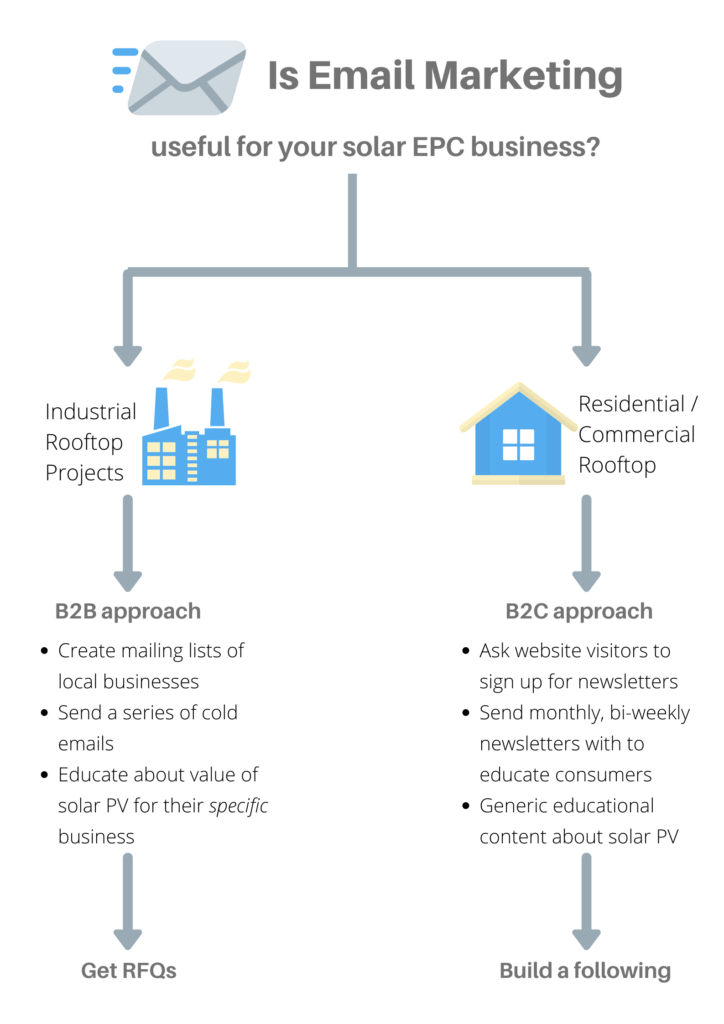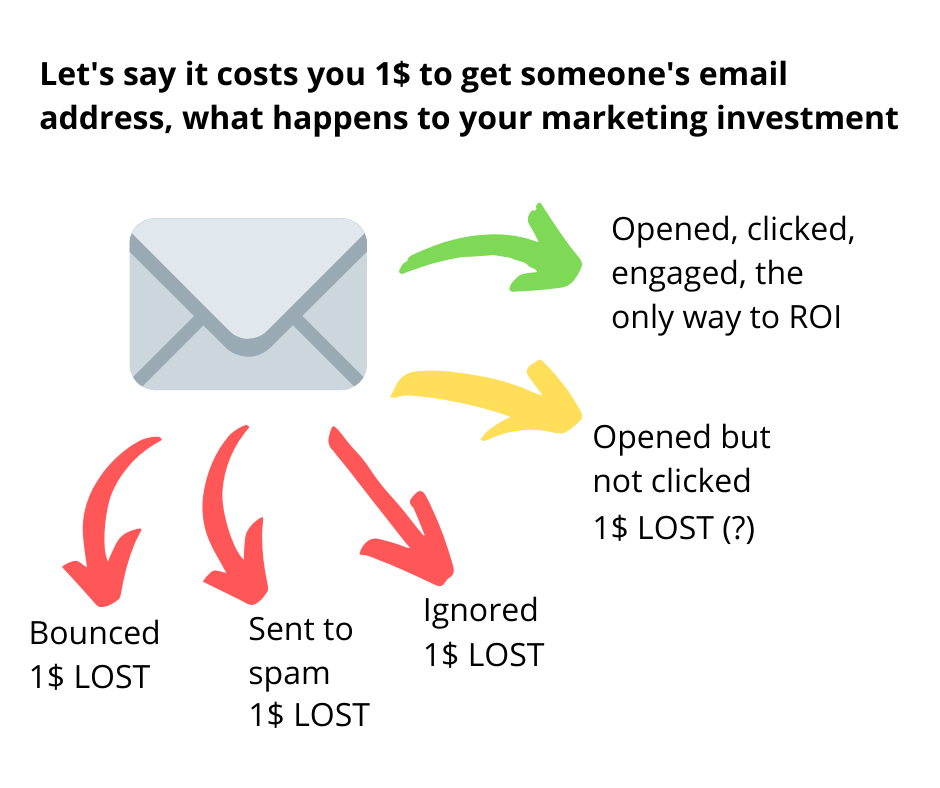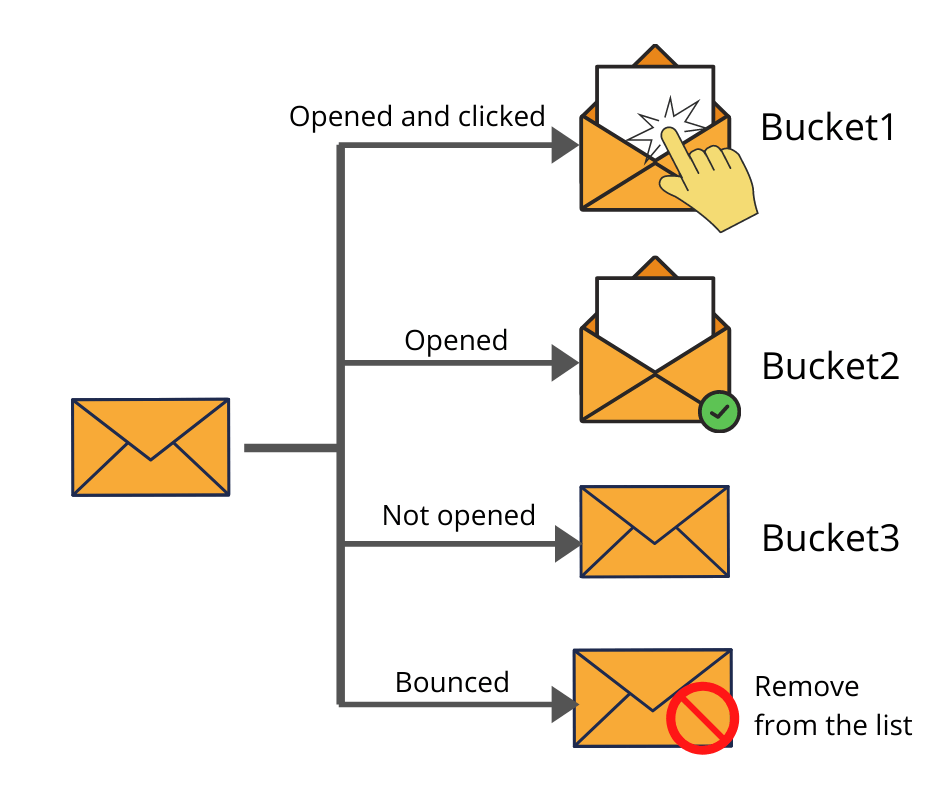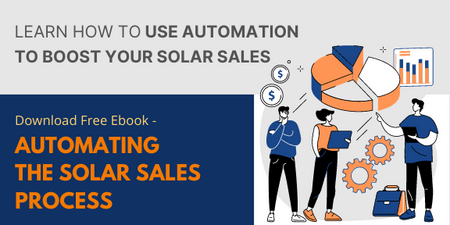Solar PV installation projects are done on a wide variety of scales.
- Utility-scale solar farms – with capacities in the range of a few hundred MW to GW.
- Industrial rooftop solar projects – few hundred kW to MW range.
- Commercial/residential rooftop solar installation projects – the smallest projects, for installing solar panels on rooftops of commercial and residential buildings.
The residential and commercial rooftop solar projects are the smallest in size, require less capital, and have much lower risks. Naturally, most new solar EPC businesses start their operations doing this type of project.
High competition
Given the low capital requirements and low risks in starting a residential rooftop solar installation business, many entrepreneurs have flocked to this space in recent years.
This has given way to intense competition in the residential (and commercial) rooftop solar EPC space. In turn, this competition has put a lot of pressure on the profit margins of these businesses.
The need to be innovative and cost effective
All other things remaining the same, success of a rooftop solar business in this space largely depends on two things –
- How cost effective are your operations? So that you can manage with the shrinking profit margins
- What is your customer acquisition cost? So that you can have better margins than your competitors
For multiple strong reasons, online marketing proves to be very cost effective compared to other traditional lead generation channels. As a residential solar installer you can count on following channels to keep on providing you leads at very low cost –
- Search engine optimization, optimize your website for localized searches of ‘solar PV installation’ services
- Business directory listings – for example, Indiamart, JustDial etc.
- Strong presence on Google searches – update the details of your business on Google Maps, Google My Business, Youtube, etc.
- Post about your successful projects on Facebook, Youtube, Twitter.
- Blog about the value that your customers have received from your projects. Educate your potential customers about the effectiveness of solar energy, till they become your customers.
So where does email marketing fit in the rooftop solar business?
There are two very different ways to use email marketing for your rooftop solar business. Both of them target two very different groups of customers.

1. Cold email marketing for industrial/commercial rooftop solar
If you are after industrial or commercial rooftop spaces, you are essentially targeting business owners. Cold emailing is a very well-proven lead generation channel in the B2B space.
For this, you need to first start with a list of businesses in your area. Today, you have many online sources that you can use to build your target customer list – LinkedIn, Indiamart, JustDial, Google Maps, etc.
Make a list of businesses that are likely to benefit from a solar PV installation project. Get the emails of their owners and managers.
Next, create an email campaign to educate these business owners on the value of solar PV installation in their facilities. Talk about the scale of investment, the payback period on their investment, your past experiences, successful project execution, etc.
But don’t cram everything into one single email. Create a series of emails talking about different things. Keep each email under 10 lines. Almost no one reads lengthy, articles or emails. Keep them simple, most people would just spend a few seconds looking at your email. They should get the gist of it, at first glance. Refer to these email marketing tips and templates for solar installation businesses before creating your email content.
Use these cold email templates as a reference point for writing your own cold email copy. Then use these follow up email templates to write the subsequent emails in your email sequence.
Once you write the content for your series of cold emails, sign up for a cold email automation app. Cold email marketing can ensure that more than 50-60% of your emails get opened, whereas bulk email tools like MailChimp only give you 12-15% opening rates.
Remember that the goal of this email campaign is to drive curiosity and generate leads. Link all the emails back to your website where your readers can come and request for a quotation – that is the ultimate goal of your lead generation campaign. Once you get the request for a quote, your sales team can take it from there.
Cold email marketing for solar
In case of solar EPC, most installers operate in specific cities or areas. They have a very limited audience to target. If you make a list of 10,000 prospects in an area, you can’t really afford to waste any of those prospect emails.

It makes a lot of sense to approach each and every prospect carefully without spamming them. Cold email marketing is best suited for such solar businesses. Even if you send 1000 cold emails per month, in 10 months you would have covered your whole target area.
If you use email tracking, you can identify who has engaged with your first round of emails. Then in the next round you can just target those people who are responsive, for better productivity from your email campaign.
2. Newsletters to build a following for your business
On the other hand, if you are going after residential rooftop installation projects, you are targeting the house owners and building societies. These are smaller projects compared to the industrial rooftop installations.
So your approach needs to be more of B2C marketing and newsletters are known to be quite effective for B2C marketing.
Building a mailing list for your newsletters is quite different from the list of businesses for cold emails. First of all, your target market is too wide to create a list of everyone’s email address. You would want to narrow it down to only the people who are actually interested in your offering. Secondly, you don’t want to send too many cold emails to thousands of strangers without their permission. That counts as spamming. Again you would want to narrow down your mailing list to only the people who are interested to know about your solar installation services.
So how do you build a mailing list for these newsletters?
You should ask your website visitors to sign up for your newsletters. You can give them incentive that they can expect discounts, offers, technical articles, updates about new products etc. in your newsletters.
The best way to get a website visitor’s email address is to ask for it on their ‘exit intent’.
Once you start building the newsletter mailing list, next you should think about the content for your newsletters. Again, the emphasis should be on educating your readers. Most people will sign up for the newsletter because they are curious about the whole solar PV thing. If you only keep talking about your company and your products, you will soon lose their interest.
The last part is about finding the best emailing tool for your newsletters. You can choose to go with a newsletter tool like mailchimp which sends thousands of emails simultaneously. But only 12-15% of those emails get opened on average. OR you can go with a cold email automation tool, which sends a lower number of emails (50-100) per day. But you get much higher opening rate in this case. For example, SafeMailer combines a mail merge tool with scheduled email campaigns to send highly personalized emails in a staggered manner. This mail merge workflow will boost your email opening rate by 3-5 times. It is a simpler and 10X cheaper alternative to woodpecker or milkshake.
But if you find it useful and recommend it to your friends, colleagues and customers, you can even use it as a free mailshake alternative.
This method will start slow. But if you keep on writing good content on the website and in your newsletters, you can develop substantial following of your business in no time.
Email marketing tips for solar businesses
Now let’s look at some cold email marketing best practices for solar installers.
Long term approach
If you are targeting a small niche of customers – geographically or industry wise – you have a limited number of businesses that can be approached on email.
If you have only 10,000 emails in your marketing database, you cannot afford to waste any of those contacts.
So instead of the ‘spray and pray’ strategy, your focus should be on maximizing the success rate of each email campaign. This is only possible with a carefully crafted sequence of drip emails.
Drip emails take longer time but give you much better cumulative results at the end.
Email frequency
In case of B2B sales, it is also important that your sales cycle matches with the buying cycle of your prospect. This will happen if you always stay on their radar in a non-intrusive way. Marketing emails sent 1-2 times in a quarter will do this trick.
When your prospect is ready to invest in solar, he should be able to recall about your business and ask for a quotation.
Different buckets of prospects
When we say “carefully crafted” sequence of emails, it refers to customizing your content for different types of recipients.
When you send your first round of marketing emails, some people will not even open it, some will open. Some of them will even come to your website and ask for pricing.
In the second round, would you send the same email to all three types?
No. Clearly these people have very different interest levels in what you have to say. So your second email should resonate with each of these different interest levels.

For example –
- To those who did not open first email, you can ask – “Did you receive my last email? Because sometimes these emails can get lost in a heap of other messages.“
- To those who opened and read it, you can send the second marketing email about – how to ensure best ROI with rooftop solar solutions.
- Finally, those people who have clicked your email and asked for a quote are clearly ready to buy. So send them a sales email – with pricing details, customer testimonial and case study.
You can divide your audience into different buckets according to their interest / engagement levels. And then send them the next email accordingly.
Clear CTAs for each bucket
Once you have divided your mailing list into multiple buckets, you can write different email content for each of those buckets.
But you also need to customize the ‘Call To Action’ (CTA) for each bucket as well. Without a clear CTA, you reduce your own chances of meaningful responses from your audience.
So every email in your drip sequence should definitely have a clear CTA. This CTA should be customized for the corresponding bucket.
For example – you can ask fresh prospects to download an ebook about – “Benefits of solar PV”, as they still need to be convinced.
For warmer prospects, you can ask them to “Download ROI calculator”. Because at evaluation stage they are most likely thinking about ROI.
Customizing the content
Similar to the CTAs, your actual email text should also be customized for each bucket.
Send marketing emails with educational content about – the benefits of solar PV, how it makes economic sense, reduced pricing, long term cost savings etc. These marketing emails should go to fresh prospects who are not yet fully convinced to go to the next stage and evaluate a solar PV solution.
Once they are ready to evaluate, they will start engaging more with your emails. They may reply on your mails or visit your website or request for pricing. At that time, you can start sending them sales emails with ROI analysis, customer testimonials, pricing for different panels etc.
Tracking email engagement
Of course, most of the recommended tips above require that you continuously track how your audience is engaging with your emails.
You need to track all bounces, opens and clicks. Accordingly, you can divide your mailing list into different buckets as the campaign progresses.
You can either use a free tool like – mailtracker to track and manually record the email opens, or you can run your solar lead generation campaigns with a tool like SafeMailer’s cold email marketing app.
It runs your campaigns in a spreadsheet and then updates the engagement data in the same spreadsheet.

Using automated workflows
Once you have the engagement data, you can either manually divide your mailing list into smaller buckets, or you can use an email marketing platform that can automate this based on configurable workflows.
For example – SafeMailer’s cold email marketing app allows you to create workflows in a simple spreadsheet. These workflows will automatically divide your mailing list into smaller buckets based on latest engagement data.
For each round of emails, different email content will be sent to different buckets as per the predefined workflows.
Other complementary channels to email marketing
When cold email marketing is done the right way, it can be very effective for solar lead generation. But you can further increase the success rate of your email campaigns by using other complementary channels.
Remarketing ads
Use Google and Facebook remarketing ads to actively stay on the radar of your prospects. These ads are most effective, when any prospect has previously shown interest in your offering.
So the simplest thing you can do is to run Google and Facebook remarketing ads for your ‘sales bucket’ where you have the prospects who are actually in your sales funnel, evaluating your PV solution. Put all your recent website visitors and people from your engaged bucket in a custom audience for remarketing campaign.
This will help you get more visibility in front of prospects who are deciding between you and other competitors.
You can also try out other ways of combing email campaigns with remarketing. The increased visibility can give you better results. But you have to balance it out with the additional costs for remarketing ads.
Social media
If you don’t want to spend a lot on online ads, ask your engaged email recipients to follow your Facebook or LinkedIn pages. This way you will have another free channel to reach them.
When they see a message twice – once in your email and again on your facebook page – that’s definitely going to have a deeper imprint in their memory.
Further you can also explore different recommended lead generation channels for residential solar and commercial solar businesses, in those respective links.
Cold emails Vs cold calls
Many SMEs in the residential solar space wonder if it is better to collect phone numbers on their websites instead of emails.
We recommend, you collect both. But you can use emails much more frequently without annoying a potential customer. For example, you can send 2-3 newsletter emails in a month and no one would block you. But if you make 2-3 cold calls in a month, you would almost surely get blocked.
And cold emails/newsletters costs so little, that they should be ALWAYS done. You can do the cold-calling campaigns on top of that.


